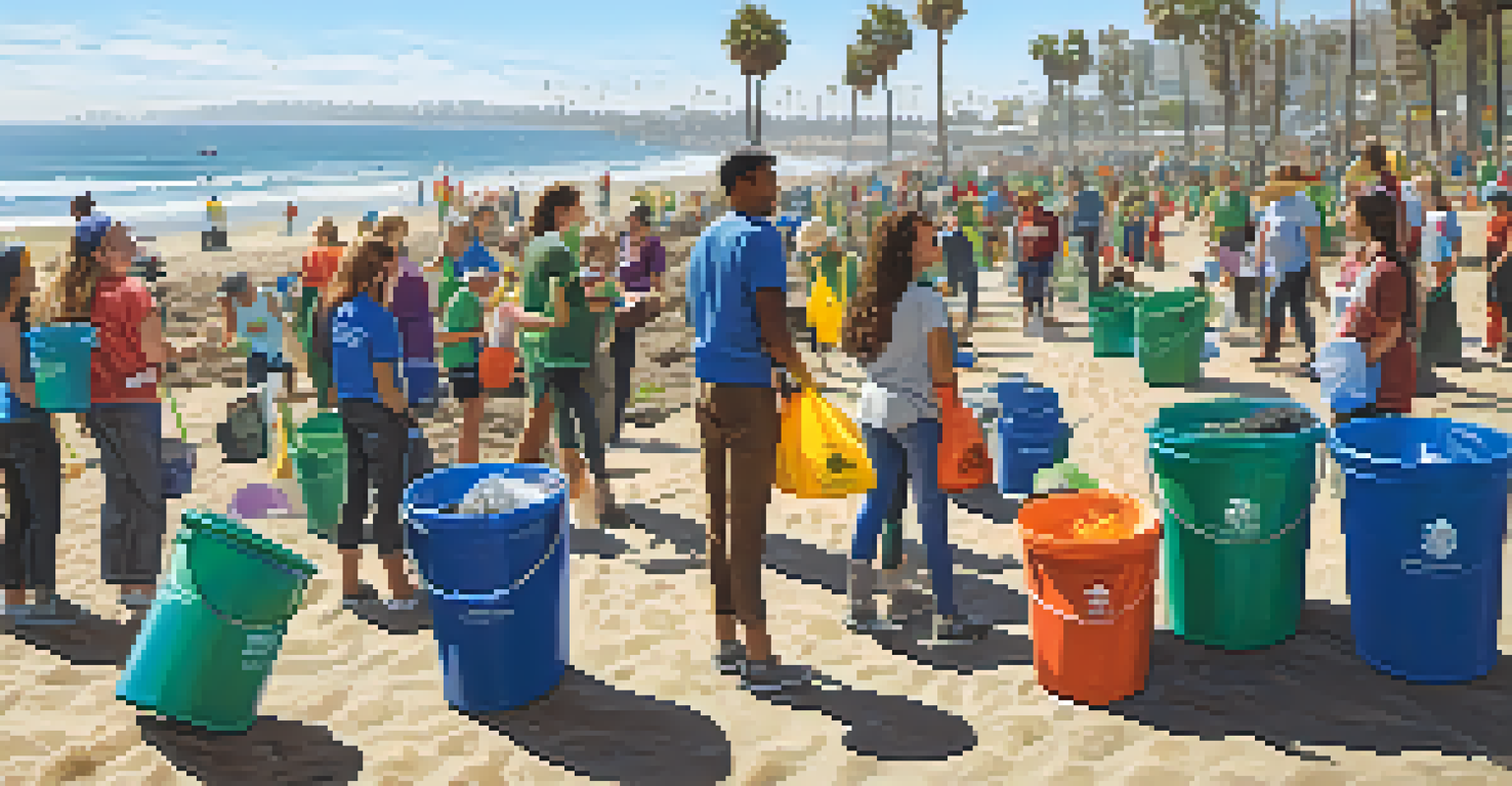San Diego's Climate Action Plan: Coastal Resilience Focus

Understanding San Diego's Climate Action Plan
San Diego's Climate Action Plan (CAP) is a roadmap designed to tackle climate change while promoting sustainability. The plan outlines various strategies that aim to reduce greenhouse gas emissions and enhance the city's resilience against climate impacts. This initiative is vital for a coastal city like San Diego, where rising sea levels and extreme weather events pose significant threats to communities and ecosystems.
The greatest threat to our planet is the belief that someone else will save it.
By integrating environmental, social, and economic factors, the CAP seeks to create a holistic approach to climate adaptation. For instance, it emphasizes renewable energy, energy efficiency, and sustainable transportation as key components to achieve its goals. This comprehensive strategy not only addresses immediate climate challenges but also sets the stage for long-term sustainability and prosperity.
Moreover, the CAP is not a static document; it evolves with input from community stakeholders, scientists, and policymakers. As the city faces new challenges, the plan adjusts to incorporate innovative solutions and best practices. This adaptability ensures that San Diego remains at the forefront of climate action, paving the way for a resilient future.
The Importance of Coastal Resilience
Coastal resilience refers to the ability of coastal communities to withstand and recover from climate-related impacts like flooding and erosion. For San Diego, which boasts beautiful beaches and a vibrant coastal ecosystem, enhancing coastal resilience is crucial for both environmental health and economic stability. The city's unique geography makes it particularly vulnerable to the effects of climate change, making this focus essential.

A resilient coastal community can better protect its infrastructure, economy, and natural resources. This means investing in green infrastructure, such as wetlands and dunes, which act as natural buffers against storms and rising seas. By prioritizing coastal resilience, San Diego not only safeguards its shoreline but also ensures the well-being of its residents and local wildlife.
San Diego's Climate Action Plan
The Climate Action Plan serves as a dynamic roadmap to reduce greenhouse gas emissions and enhance resilience against climate impacts.
Furthermore, coastal resilience is about more than just physical protection; it's also about fostering community engagement and awareness. Local initiatives encourage residents to participate in conservation efforts, such as beach clean-ups and habitat restoration projects. This community involvement helps build a culture of resilience that can adapt to future challenges collaboratively.
Strategies for Enhancing Coastal Resilience
San Diego's Climate Action Plan outlines several strategies explicitly aimed at enhancing coastal resilience. One of the primary approaches is to establish protective measures, like sea walls and living shorelines, which can absorb storm impacts and reduce erosion. These strategies not only protect infrastructure but also preserve vital habitats for marine life.
We won't have a society if we destroy the environment.
Additionally, the CAP emphasizes the importance of restoring natural ecosystems, such as wetlands and mangroves, which play a critical role in coastal defense. These ecosystems act as natural barriers against flooding and provide essential services like water filtration and carbon sequestration. By investing in these natural solutions, San Diego can enhance its resilience while also promoting biodiversity.
Another key strategy involves community education and outreach. By informing residents about the risks associated with climate change and the steps they can take to mitigate these risks, the city fosters a proactive approach to coastal resilience. Engaging the community in these efforts ensures that everyone plays a part in protecting the coast and preparing for future challenges.
Community Involvement in Coastal Resilience
Community involvement is a cornerstone of San Diego's approach to enhancing coastal resilience. The Climate Action Plan encourages residents to actively participate in local initiatives, educational workshops, and decision-making processes. This engagement builds a sense of ownership and responsibility towards the coastal environment.
Local organizations and community groups play a vital role in fostering awareness and action around climate issues. For example, beach clean-up events and tree-planting initiatives bring residents together to contribute actively to their environment. Such grassroots efforts not only beautify the coast but also strengthen community bonds and resilience.
Coastal Resilience is Essential
Strengthening coastal resilience is vital for protecting San Diego's infrastructure, economy, and natural resources from climate-related threats.
Moreover, community feedback is essential for the continuous evolution of the Climate Action Plan. Regular public forums and consultations allow residents to voice their concerns and share their insights. This collaborative approach ensures that the strategies implemented are relevant and effective, ultimately leading to a more resilient coastal community.
Innovative Technologies Supporting Resilience
In the quest for coastal resilience, San Diego is leveraging innovative technologies to address climate challenges. For instance, the use of Geographic Information Systems (GIS) allows planners to visualize and analyze coastal vulnerabilities in real-time. This technology aids in identifying areas most at risk and developing targeted strategies to enhance resilience.
Smart sensors and monitoring systems are also being integrated into the city's infrastructure. These devices can track environmental changes, such as sea level rise and erosion patterns, providing valuable data for informed decision-making. By harnessing technology, San Diego can respond more swiftly to emerging threats and adapt its strategies accordingly.
Additionally, public access to this data empowers residents to engage with resilience efforts. Online platforms that display real-time information about coastal conditions encourage community vigilance and participation. This tech-savvy approach not only enhances preparedness but also fosters a culture of innovation in tackling climate challenges.
Partnerships Driving Coastal Resilience Initiatives
Collaboration is key to the success of San Diego's Climate Action Plan, particularly in enhancing coastal resilience. The city works closely with various stakeholders, including government agencies, non-profits, and academic institutions, to implement effective strategies. These partnerships allow for the pooling of resources, expertise, and innovative solutions to address complex climate challenges.
For example, collaborations with environmental organizations help facilitate restoration projects along the coast, such as replanting native vegetation and creating buffer zones. These joint efforts not only improve ecological health but also provide recreational opportunities for residents. By working together, these partnerships maximize the impact of resilience initiatives.
Community Engagement Drives Success
Active community involvement is crucial for the success of resilience initiatives, fostering a strong sense of ownership and collaboration among residents.
Furthermore, engaging with regional and national networks allows San Diego to share best practices and learn from others facing similar challenges. This exchange of knowledge fosters a culture of continuous improvement and innovation in climate action. As a result, San Diego is better equipped to adapt to climate change and enhance its coastal resilience.
Future Outlook for San Diego's Coastal Resilience
Looking ahead, San Diego's commitment to coastal resilience is stronger than ever. The Climate Action Plan lays a solid foundation for future initiatives aimed at addressing climate change's impacts on coastal communities. With ongoing investments in green infrastructure and community engagement, the city is poised to tackle emerging challenges effectively.
As climate science continues to evolve, so too will the strategies outlined in the CAP. Regular assessments and updates ensure that the plan remains relevant and responsive to new information and trends. This proactive approach is crucial for maintaining the city's resilience in an ever-changing climate landscape.

Ultimately, the success of San Diego's efforts hinges on the collective action of its residents, businesses, and government. By fostering a culture of sustainability and resilience, San Diego can serve as a model for other coastal cities facing similar challenges. The journey toward a resilient future is ongoing, but with dedication and collaboration, San Diego is well on its way.